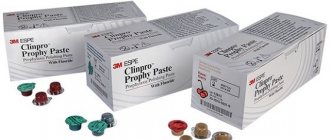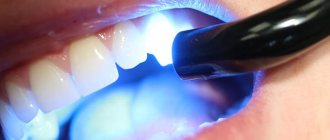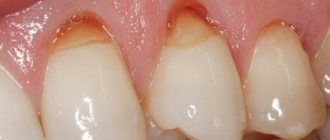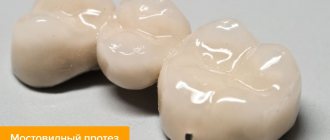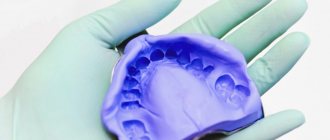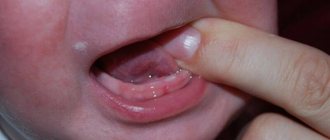Dental deposits are plaque and tartar that form on the surfaces of teeth and accumulate in the supragingival and subgingival space. Dental plaque not only makes our teeth unsightly - dull and yellow, but they contribute to the development of a wide variety of dental diseases of the teeth and gums. It is for this reason that it is imperative to remove dental plaque and do it in the dentist’s office, using professional techniques and equipment.
How dental plaque is removed in dentistry, by what methods and what is the price for the service in Moscow - we will answer all these questions in detail in this article.
What is dental plaque and how is it removed in dentistry?
Dental plaque is plaque that remains on the teeth after eating or drinking. This plaque contains large quantities of various bacteria and pathogenic microorganisms that harm the health of our teeth and gums. If soft dental deposits are not removed by regular brushing, they will gradually harden and turn into stone, which cannot be removed at home. Both hard and soft deposits on teeth increase the risks of developing caries, periodontitis and periodontal disease. Therefore, you need to deal with their timely removal.
Some people think that brushing their teeth every day will be enough to completely remove plaque, but this is not true. Even if you carry out dental hygiene according to all the rules and using all the recommended tools (brushes, brushes, floss), you will still not be able to carry out high-quality removal of deposits from hard-to-reach places in the oral cavity - interdental spaces, in the space above and below the gums. For this reason, to remove dental plaque, you need to go to dentistry and carry out the procedure using professional techniques and instruments.
To remove dental plaque in modern dentistry, various methods are used, and below we will consider in detail the most popular methods of cleaning teeth and the oral cavity from plaque and tartar.
Calculate the cost of treatment by taking a short test in 20 seconds!
Do not delay your treatment, because in this matter time plays against us.
What is the danger of tartar
Why is it so important to see a dentist? There are several unpleasant and dangerous consequences of tartar:
- halitosis or bad breath - as a result of the constant proliferation of pathogens;
- inflammation of the gums - gingivitis, periodontitis, as well as inflammation of the mucous membranes of the oral cavity (tongue, cheeks, lips, etc.) - microbes release toxins, inflammatory mediators, which causes the inflammatory process;
- spread of inflammation - in the absence of treatment, inflammation covers the tissues that hold the teeth in the jaw, the dentogingival attachment is disrupted, which leads to periodontitis and periodontal disease: loosening, the appearance of periodontal pockets with purulent contents, bone tissue atrophy, exposure of the necks of the teeth, and their loss;
- caries - soft and hard deposits contain microorganisms that provoke the appearance of caries. This occurs due to the release of hydrochloric acid, which destroys the enamel. The resulting defect is populated by pathogenic flora and a carious cavity is formed;
- general deterioration of condition and well-being - toxins released by bacteria are absorbed into the blood, which complicates the course of chronic diseases and can affect the functions of organs and systems.
That is why, regardless of the cause of tartar, it is important to seek professional dental help - removal.
Removing dental plaque: methods used in modern dentistry
To remove dental plaque in dentistry, physical and hardware methods can be used. In the first option, special tools are used to remove deposits - stone and plaque - hooks, scalers, finishers. However, the physical method of removing dental plaque is used quite rarely, only when there is a need to remove tartar from deep gum pockets, from which it is difficult to remove it in other ways.
Why has removing dental plaque with hand instruments become unpopular among modern dentists? It's simple, this method is less advanced than modern technologies for removing plaque and tartar. Manual removal of dental plaque is a labor-intensive process, the effectiveness of which will largely depend on the level of knowledge and qualifications of the dentist. Moreover, when manually removing dental deposits, irregularities remain on the teeth, in which plaque will accumulate even more actively.
Due to the considered disadvantages, manual removal of dental plaque is rarely carried out; hardware methods for removing plaque and tartar are more often used - Air Flow technology and ultrasonic cleaning.
Air Flow technology for removing dental plaque
This technology is ideal for removing soft and pigmented deposits from tooth surfaces.
The procedure for removing plaque is quick and without discomfort for the patient and, in addition to removing plaque, it helps to lighten the tooth enamel a little - by approximately 2-3 shades, to its natural shade. When removing dental plaque using Air Flow technology, teeth are cleaned by applying a powerful air-water flow to their surface, which contains abrasive particles (soda).
Air Flow dental plaque removal is an effective and gentle method of combating plaque, but with all its advantages, it does not help get rid of tartar. To carry out high-quality removal of hard dental deposits, teeth are cleaned with ultrasound. We will talk about this technology in detail in a separate section of our article.
Kinds
Plaque is divided into two categories. First, supragingival stone appears, the cause of which is poor oral hygiene. Such deposits are located above the upper edge of the gingival crest, so they are easily diagnosed during a routine examination.
The characteristic features of supragingival tartar include:
- Localization on the inner surface of the tooth, from the side of the tongue;
- White or yellowish tint;
- The consistency is hard or clay-like.
The plaque is unstable, so it can be removed mechanically without any problems.
Subgingival calculus appears as a result of the fact that supragingival plaque descends down the root of the tooth and mineralizes. It forms in the gum pocket and is diagnosed only when using special dental instruments. Such deposits are considered age-related and most often appear in people over 40 years of age. If personal hygiene rules are not followed, it can appear at any age.
Signs of tartar:
- Dense and hard consistency;
- Light brown or greenish-black tint;
- Swelling and bleeding gums.
Ultrasound removal of dental plaque: features, stages and prices
Ultrasound removal of dental plaque is a modern and highly effective method of oral hygiene. Ultrasound will help:
- Carry out the removal of supragingival and subgingival tartar;
- Quickly remove pigmented plaque;
- Eliminate soft microbial plaque.
Removing dental plaque is a procedure that is carried out in three stages. Below we will tell you in detail how the process of removing dental plaque with ultrasound will take place in the dentist’s office.
STEP 1: Ultrasound removal of plaque and tartar
Ultrasound removal of dental plaque is carried out using special equipment - ultrasonic scalers.
Scalers can be either a separate device or part of a dental unit. The main working element of the scaler is its tip with a metal attachment. The tip of this metal nozzle vibrates at high frequencies in the ultrasonic range. Also, water is supplied through the nozzle, which washes away decayed dental plaque from the patient’s mouth and is immediately removed with a saliva ejector.
What it is
Tartar is a hardened plaque that forms in adults and very rarely in children, and even then in the presence of a history of serious diseases such as heart disease or diabetes. Usually, if you spend enough time on hygienic procedures to remove plaque, stones will not form on your teeth. If plaque is not allowed to harden, stones cannot form. Therefore, thorough brushing of teeth is the best means of prevention.
Tartar can occur on one single tooth or on several teeth. The lower front teeth, as well as the upper and lower molars, are most susceptible to tartar formation.
Signs:
- Tartar causes bad breath;
- gums begin to itch and bleed;
- Dark stains appear on the visible surfaces of the teeth that cannot be removed with a brush.
Tartar can form not only on enamel, but also on crowns or dentures. Therefore, those who do not have their own teeth in their mouth, but only dentures, should not relax - stone can form on them, just like on the surface of the enamel. It, of course, will not lead to caries on the crown, but it can provoke inflammation of the gums, and also significantly spoil the appearance of the dentures.
Plaque from tea and cigarettes can provoke the formation of tartar. The constant presence of such plaque on hard-to-reach enamel surfaces inevitably leads over time to the formation of dense deposits, including stones.
Free consultation on the cost of treatment in our dentistry
Leave a request and the clinic administrator will contact you within 15 minutes!
The scaler effectively removes dental plaque because:
1. Its nozzle creates oscillatory movements that destroy plaque and tartar. In order for the removal of dental plaque to be carried out efficiently and without damaging the teeth, it is extremely important that the vibrations of the nozzle are directed along the dental surfaces.
2. During the operation of the scaler, water is supplied to the oral cavity, which is needed not only to wash out destroyed deposits and cool the nozzle. Ultrasound in an aqueous environment creates many small bubbles, which immediately burst, releasing a large amount of energy. This energy promotes improved removal of dental plaque from tooth enamel, and in addition, helps eliminate pathogenic microflora in the oral cavity.
After removing plaque, the second stage of ultrasonic cleaning is carried out - teeth polishing.
STEP 2: Polishing teeth after removing dental plaque with ultrasound
Polishing teeth after removing dental plaque is an event that must be carried out without fail.
After removing deposits with ultrasound, microscopic particles of plaque and stone may remain on the dental surfaces, making the tooth enamel uneven and rough, which will provide optimal conditions for the accelerated accumulation of a new layer of plaque. Polishing teeth after removing deposits can be done with hand tools, but most often the Air Flow technology is used for polishing, which we briefly told you about above. When manually polishing teeth, after removing plaque, pastes, brushes and strips are used - thin strips with an abrasive layer, which polish the space between the teeth.
STAGE 3: Remineralization of teeth after removal of plaque and tartar
This stage is not considered mandatory and, moreover, many clinics do not include it in the procedure for professional removal of dental plaque.
However, remineralization must be carried out after removing plaque and tartar from the teeth. It helps strengthen tooth enamel and relieve sensitivity that may occur in the neck area of teeth after plaque removal. Remineralization of teeth is carried out immediately after removing plaque and tartar and uses special preparations based on sodium fluoride.
Who is contraindicated for dental cleaning?
Manual removal of tartar or soft plaque has practically no contraindications, which cannot be said about the use of devices. Such removal of deposits is contraindicated in the following conditions and pathologies:
- for heart diseases;
- if there are implants in the oral cavity;
- bronchial asthma and bronchitis;
- presence of hepatitis and tuberculosis;
- diabetes;
- if there is increased sensitivity, which can provoke a gag reflex;
- during pregnancy and while breastfeeding, it is better to refrain from such procedures;
- Such methods are also contraindicated for children and adolescents.
When visiting a dentist, you must inform him about the presence of chronic pathologies or existing acute diseases.
Advantages of ultrasonic dental plaque removal
Ultrasound removal of plaque and tartar has a number of advantages. First of all, it is worth noting the high efficiency and versatility of the technology: it is ideal for removing pigmented plaque and perfectly removes stone from the most inaccessible areas of the oral cavity, even from deep periodontal pockets.
Removing plaque and tartar with ultrasound helps destroy pathogenic microflora in the oral cavity and, what is especially important, cleans periodontal pockets from pathogenic bacteria.
A clear advantage of removing dental plaque with ultrasound is the affordable cost of the procedure. On average, you will have to pay 4-5 thousand rubles for removing plaque and tartar, polishing and remineralizing teeth.
Mechanism of formation of tartar
The causes of tartar are as follows: after eating food, particles remain in the mouth. They act as a favorable environment for the proliferation of pathogenic bacteria. They give greater preference to easily digestible carbohydrates: particles of sweet food, baked goods. Experts have found that even one day of lack of hygiene doubles the amount of bacterial plaque in the mouth.
Nutrients are used by microorganisms for more than just reproduction. They also secrete special enzymes - enzymes, which allow them to firmly attach to the surface of the tooth enamel. Lack of hygiene leads to the fact that individual pinpoint colonies quickly merge into one “plaque”, forming an impressive mass of plaque. Before it begins to mineralize, it can be easily brushed off with a toothbrush.
With the gradual mineralization of soft deposits, stone formation occurs. Calcification occurs as follows: calcium salts, which are part of saliva, settle on the soft plaque. Mineralization is accompanied by the process of layering of new and new colonies of bacteria, which leads to an increase in the volume of solid deposits.
The mechanism of tartar formation is accompanied by processes such as the release of toxic substances and inflammatory mediators by plaque. This becomes the cause of inflammatory processes in soft tissues. Symptoms of this complication are:
- bleeding of the gums - due to mechanical stress, and in severe cases, spontaneous;
- redness, cyanosis, swelling of the gums;
- soreness, itching;
- the appearance of pus in periodontal pockets;
- mobility of individual teeth.
Inflammation contributes to an even greater increase in the number of bacteria. In the place where the gums adhere to the surface of the tooth there is a periodontal groove, into which liquid with salts and proteins is produced from the gums. This leads to the growth of bacterial colonies. With inflammation, this fluid becomes larger, resulting in an environment for reproduction that is even more favorable for microorganisms. Calcification occurs even faster.
Are there any disadvantages to ultrasonic tartar removal?
There are no downsides to the technology of removing tartar using ultrasound - it is the most modern and effective method of professional oral hygiene. However, before you go to the dentist’s office to remove tartar with ultrasound, you should find out the level of competence of the doctor, as well as the level of equipment of the clinic.
Why is it important? The fact is that if the removal of tartar and plaque from teeth is carried out by an inexperienced or illiterate specialist, or using outdated equipment, there is a high risk of damage to tooth enamel and poor quality of cleaning them from deposits.
Causes of tartar
So, we have figured out the mechanism for the appearance of solid deposits. What causes tartar and what contributes to its rapid formation? There are several factors:
- Ignoring hygiene, improper brushing of teeth. An increase in the volume of bacterial plaque leads to rapid mineralization and proliferation of the stone;
- consumption of carbohydrates (sweets, baked goods), preference for soft foods (lack of natural mechanical cleaning with solid foods);
- changes in the composition of saliva, its acidity or increased salivation as a result of metabolic disorders lead to rapid saturation of soft deposits with calcium salts;
- internal diseases, inflammatory, infectious, which causes a large number of pathogenic bacteria;
- rough surface of the teeth - “simplifies” the formation of soft and hard plaque;
- bite defects, which makes it impossible to properly clean some areas (for example, when teeth are crowded);
- taking certain medications that help change the composition of saliva.
The causes of tartar formation can be combined with each other. When visiting a dentist, it is important to find out about them in order to select effective methods of prevention.
How to preserve the results of dental plaque removal for a long time?
In order for the positive results of cleaning to last for a long time after removing plaque and tartar, you need to learn how to properly care for your teeth. Here are the recommendations that dentists give to their patients:
- Choose and use in dental and oral hygiene the brush and paste that suits you - your type and condition of tooth enamel;
- Brush your teeth at least twice a day - before breakfast and before bed. Try to rinse your mouth after every meal; • Brush your teeth in a circular motion for 3-5 minutes;
- Use rinses and dental floss to remove plaque from interdental spaces and other places in the mouth that are difficult to clean with a regular brush;
- Teeth need to be brushed from all sides, in addition, the tongue and gums need to be cleansed;
- Try to drink coffee and tea less often, and it’s better to quit smoking altogether. It is these habits that contribute to the rapid formation of pigmented plaque.
And of course, don’t forget that professional dental plaque removal is a procedure that should be carried out at least twice a year!
Causes of deposits on teeth
When dental plaque forms, the reasons for this phenomenon can be identified as follows:
- Using toothpastes that do not meet all requirements.
- Brushing your teeth with a soft brush, which does not cope 100% with its task.
- Low content of vegetables, fruits and other solid foods in the diet.
- The diet is dominated by thermally processed food, which easily gets clogged between the teeth.
The most important reason for the appearance of deposits on teeth is poor oral hygiene or incorrect teeth cleaning technique. It is important to know that the teeth brushing procedure should last from 3 to 5 minutes, only then can you effectively get rid of all deposits.
Is it harmful - ultrasonic removal of dental plaque?
Many patients are interested in the question of the safety of ultrasonic removal of dental plaque. We hasten to reassure you - the safety of the procedure has long been proven and confirmed by a number of clinical studies. The use of ultrasonic equipment to remove plaque and tartar from teeth does not cause any negative side reactions or pathological changes in the human body.
However, it is worth considering that there are a number of contraindications to the procedure that must be taken into account. Ultrasound removal of dental plaque should be avoided if you have serious pathologies of the heart and blood vessels, severe respiratory diseases, pathological tooth sensitivity, and ultrasonic teeth cleaning is not performed in children and adolescents.
During pregnancy, it is possible to remove dental plaque with ultrasound, but not in the first trimester.
Calculate the cost of treatment by taking a short test in 20 seconds!
Do not delay your treatment, because in this matter time plays against us.
Diagnostics
Pathology can be detected by visual examination. Even with insignificant volumes of deposits, they are indicated by:
- redness and swelling of the gums;
- increased temperature of inflamed tissues;
- tooth mobility;
- pain when pressing on an area with signs of hyperemia.
A periodontal probe allows you to detect the location of the stone. In addition, some of the deep deposits are visualized on an x-ray of the dentition.
Cost of dental plaque removal
We have already written above that this procedure has a cost that is quite affordable for a wide range of patients. But in different clinics the price may be different: this is explained by the fact that different dentists include a different set of procedures in the dental plaque removal service. Most often, a complex is offered that includes ultrasonic teeth cleaning, Air Flow polishing and fluoridation. The cost of such a comprehensive service in Moscow will start at 4,500 rubles.
You can undergo the procedure for removing dental plaque in comfortable conditions and using ultra-modern technologies and equipment in our dental clinic in Moscow - VENSTOM. You can find out all the details about the service and about making an appointment with our specialists by writing to the chat on our website or calling us!
Prevention
The main task of the patient is to reconsider his attitude towards oral hygiene, since it is due to insufficient or improper brushing of teeth that stones form on their surface. It is very important to brush your teeth twice a day, morning and evening. But it is equally important to do it correctly, thoroughly cleaning all surfaces of the teeth, including hard-to-reach ones, from plaque. This is exactly what a hygienist can teach you, as well as select the toothpaste you need and recommend a brush of the required hardness.
Dentists recommend not saving on high-quality toothpastes and brushes, since the effectiveness of hygiene procedures depends on them. Using an electric brush with various attachments allows you to more thoroughly clean the surface of your teeth from plaque. Dentists also recommend professional teeth cleaning at least twice a year, during which the doctor will remove all dental deposits that can turn into stone over time. It is also necessary to consume solid food, which helps to cleanse teeth of plaque.
Why does plaque form?
Dental plaque forms on the teeth of all people. They are the cause of many dental pathologies. Normally, the mouth contains oral fluid (saliva), microorganisms, and food debris. Immediately after brushing, a pellicle appears on the surface of the tooth - a transparent film consisting of salivary proteins. It plays a protective role, but also promotes the attachment of microbes to the surface of the tooth. Already 2-3 hours after cleaning, microorganisms are deposited on the pellicle, and after eating food particles become deposited. Throughout the day, plaque forms, which is localized in the cervical area of the tooth.
With regular care, plaque is easily removed, but with poor hygiene, its remains remain in the most inaccessible places: under the gums, between the teeth. Over time, salts are deposited in the soft plaque, which becomes hard and can only be removed by a dentist using special instruments.
There are factors that contribute to the formation of plaque:
- Poor level of hygiene;
- Violation of saliva properties (quantity, viscosity, pH);
- Incorrectly selected brush and paste;
- The predominance of soft food in the diet;
- Metabolic diseases, especially mineral metabolism;
- Diseases of the salivary glands;
- Excessive consumption of coffee, tea, pigmented foods;
- Some diseases of the body (gastrointestinal diseases, diabetes mellitus);
- Bad smoking habit;
- Decreased immunity.
Comprehensive teeth cleaning: service from our dentistry in Moscow “Aesthetica”
To ensure high-quality removal of tartar, we offer our patients a comprehensive teeth cleaning service, which includes:
- Ultrasonic cleaning;
- Air Flow cleaning;
- Grinding and polishing of enamel;
- Fluoridation.
An integrated approach to teeth cleaning guarantees a high quality procedure and is an excellent prevention of caries and gum inflammation. After the cleaning procedure, our hygienists will definitely give you recommendations on proper oral hygiene to help keep your teeth beautiful and healthy.
In our clinic, modern equipment is used to carry out comprehensive teeth cleaning, and all conditions have been created for comfortable treatment and procedures. We are proud that we can offer you the best dental technologies, high-quality materials from world-famous manufacturers and, of course, our professionalism, knowledge and experience.
Dental clinic “Aesthetica” - with us your teeth will be healthy and your smile will be dazzling! Come to us: we have opened two branches for you in Moscow - in Barvikha and in Podsosensky Lane!
